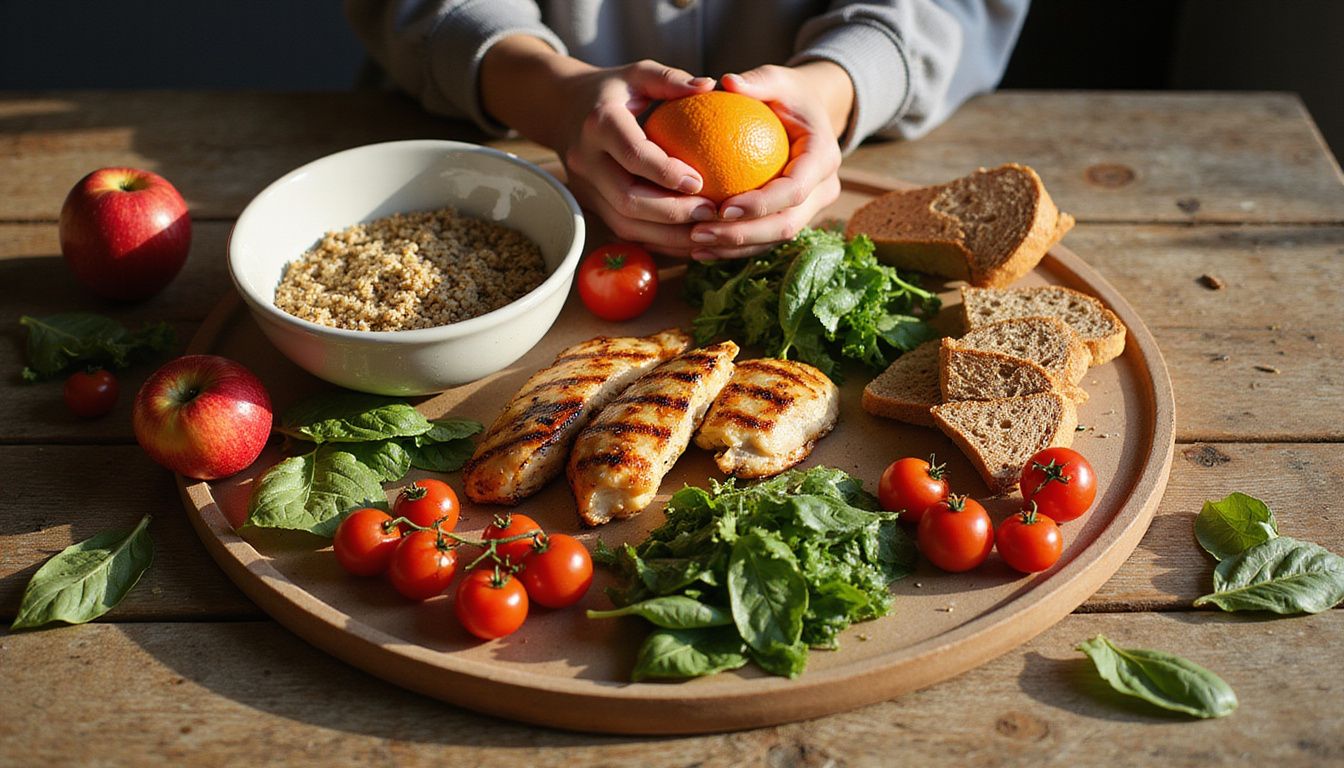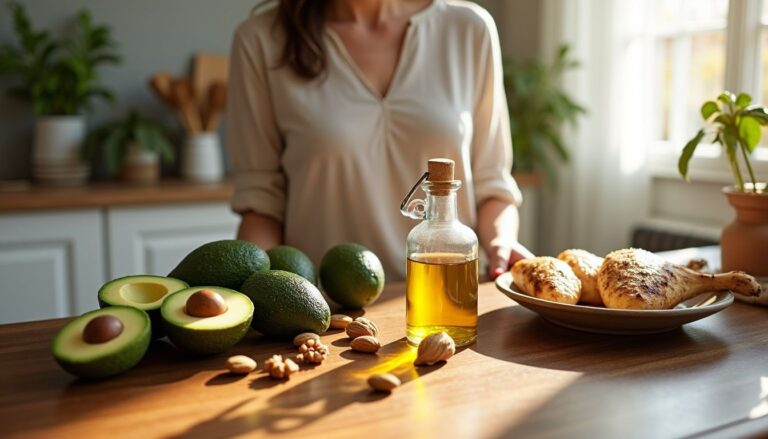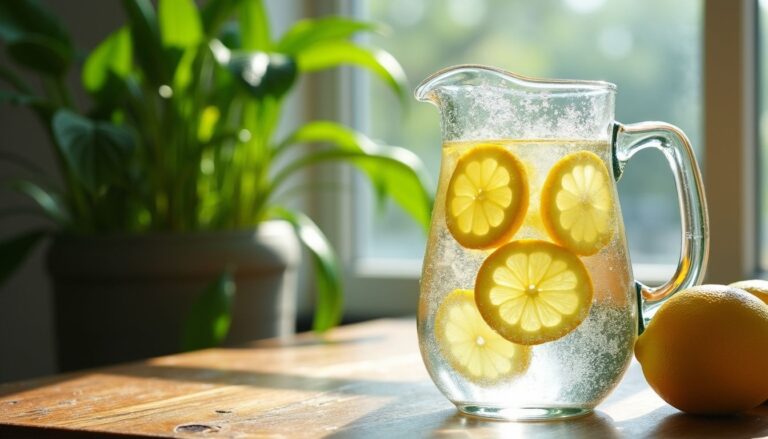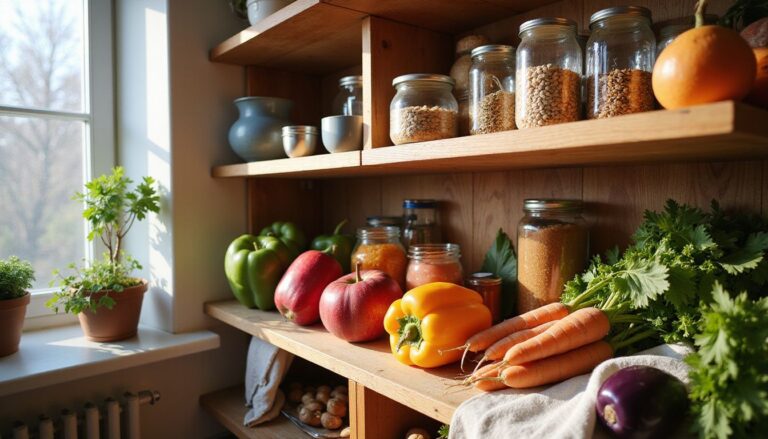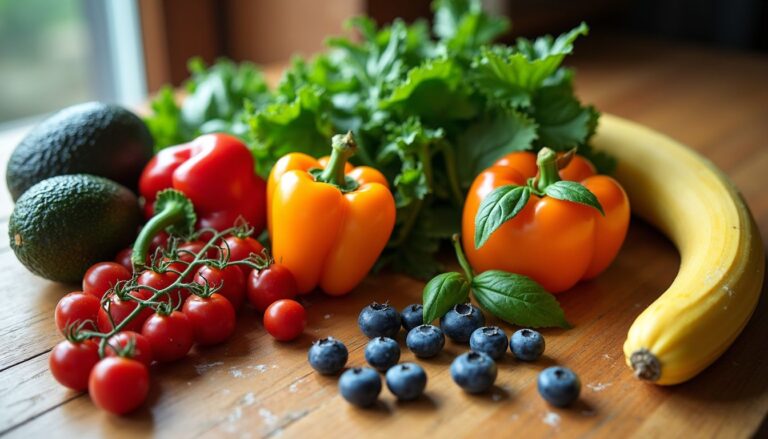Best Foods For Cutting: Top Options For A Fat-Cutting Diet
Our Nutrition Assistant AI Suite will transform your body. You will lose fat, get toned, and build muscle. Gain confidence and optimal health.
Cutting body fat while keeping muscle is hard, and food choices can feel confusing. A smart cutting diet uses the best foods for fullness, steady energy, and muscle protection. Research shows higher protein, like eggs at breakfast, helps you feel full longer during fat loss.
This guide highlights what to eat, why these foods help, and how to use them day to day. You will see simple tips supported by research, so you can move toward your goals with confidence.
Key Takeaways
- Eating in a calorie deficit of about 1,600–1,800 daily calories for many adults, while prioritizing protein, can support losing 1–2 pounds per week and help preserve muscle.
- Aim for 30–40% of calories from protein, roughly 0.8 grams per pound of body weight. Lean sources like skinless chicken, fish, Greek yogurt, and beans improve satiety and muscle retention.
- High-fiber foods such as leafy greens, cruciferous vegetables, whole grains like quinoa, beans, and lentils reduce hunger and support lasting fat loss, according to recent peer-reviewed studies.
- Healthy fats from avocados, nuts, chia seeds, olive oil in moderation, and fatty fish improve fullness and vitamin absorption without adding a lot of extra calories.
- Hydrate well. Drinking water before meals can trim calorie intake at main meals, and green tea or black coffee offer near zero-calorie hydration that fits a cutting plan.
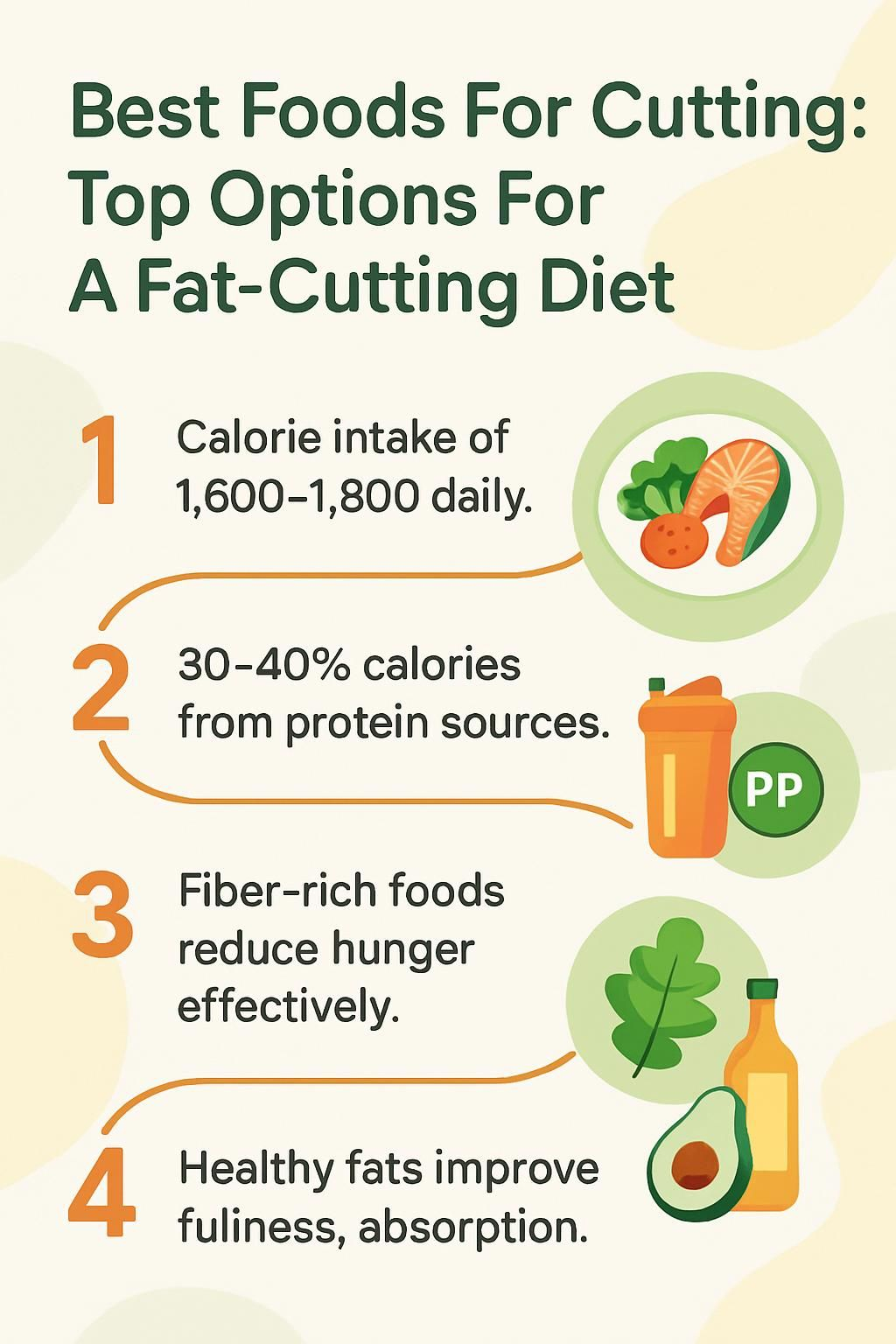
What Is a Cutting Diet?

A cutting diet, sometimes called shredding, is a plan to lose body fat while maintaining muscle mass. You eat fewer calories than your body needs each day, which creates a calorie deficit.
The goal is simple. Burn fat stores, but keep as much muscle as possible. Many plans use a macro split near 30–50% carbohydrates, 30–40% protein, and about 20% fat. You focus on nutrient-dense foods, lean protein, high-fiber vegetables, and less saturated fat.
People in bodybuilding often cut after a bulk to look leaner without losing muscle. A sustainable approach favors whole foods, steady protein intake, and healthy fats while limiting empty calories from sweets and sugary drinks.
Planning meals around grilled chicken, leafy greens, Greek yogurt, and whole grains kept me full longer during my cut. This method works for beginners and experienced lifters if you adjust calories to match your weight management goals.
Small healthy changes across the year support better health and steady weight loss over time.
Understanding Calorie Deficit
A calorie deficit means you eat fewer calories than your body burns. This gap helps you lose weight, and with enough protein, you protect lean body mass.
How Many Calories Do You Need to Eat to Cut Fat?
To lose fat, you must eat less than your body burns each day. Start by estimating your Basal Metabolic Rate, the calories you burn at rest, then factor in your Total Daily Energy Expenditure, which includes activity.
Online calculators use age, weight, height, sex, and activity level to estimate your needs. If your TDEE is 2,000 calories, many people lose weight steadily at 1,600–1,800 calories. This range is often enough to cut fat without risking muscle loss.
A common macro split for cutting is 30–50% carbohydrates, 30–40% protein, and about 20% fat. Each gram of protein or carbohydrate has 4 calories, while each gram of fat has 9 calories.
Calories add up fast. For example: chicken with brown rice and broccoli, about 300 calories; a lean shake, around 240; Singapore noodles, near 415. That simple plan totals close to 1,395 calories.
“Slight reductions in daily calorie intake help with weight loss while supporting muscle maintenance.”
Using a macro tracking app and prepping lean proteins with vegetables helped me keep energy high without constant hunger. Current research supports modest deficits for healthy weight loss in active adults.
What Are Tips for Sustainable Weight Loss?
Lasting weight loss builds from small, steady habits. Use proven methods and set realistic milestones.
- Eat in a calorie deficit that supports losing 1–2 pounds per week. This pace trims fat while protecting muscle mass.
- Prioritize protein at each meal. Aim for at least 0.8 grams per pound of body weight during calorie restriction.
- Fill half your plate with high-fiber vegetables like spinach, broccoli, and kale to stay satisfied.
- Choose nutrient-rich foods. Pick whole grains, fruit, olive oil, nuts, and lean meats or plant proteins.
- Allow planned treats that fit your calorie and protein goals. This keeps your plan sustainable.
- Avoid skipping meals. A regular schedule supports appetite control and steady energy.
- Track calories and protein if helpful, but skip strict tracking if you have a history of an eating disorder.
- Lift weights and include cardio. Training supports fat loss and muscle maintenance.
- Drink plenty of water and use low-calorie drinks to stay hydrated.
- Talk with a healthcare professional before making major diet changes, especially if you have medical needs.
- Vary your meals to cover vitamins and minerals. Variety reduces deficiency risk.
Key Nutrients for a Cutting Diet
Your results improve when you hit key nutrients. Protein protects muscle, fiber helps you feel full, and healthy fats support hormones and vitamin absorption.
Why Is Protein Important for Muscle Preservation?
Protein is essential for muscle during a cut. If you restrict calories without enough protein, your body may break down skeletal muscle, not just adipose tissue.
Aim for 1.8 to 2 grams of protein per kilogram of body weight daily. Some research suggests up to 2.4 grams per kilogram can help preserve lean mass under heavy training or deeper deficits.
High-protein foods like chicken, fish, beans, eggs, and dairy provide the building blocks your muscles need. A gram of protein has 4 calories, which makes planning easier inside a deficit.
After raising my protein intake, I noticed less soreness and better gym performance. A quick whey shake after training and casein before bed helped me stay on track.
How Does Fiber Help You Feel Full?
Protein protects muscle, and fiber supports fullness. High-fiber foods like leafy greens, beans, lentils, and cruciferous vegetables expand in the stomach and slow digestion.
A 2022 review found diets rich in chia seeds, whole grains, and legumes may reduce body fat, including in adults with type 2 diabetes. Chia seeds are easy to add to yogurt and reduce intake at the next meal in studies using 7 to 14 grams.
Boiled white potatoes rank high on the Satiety Index. Cooling them forms resistant starch, which is linked with better appetite control. Fruits, vegetables, and legumes are practical choices to manage hunger on a cut.
What Are the Benefits of Healthy Fats?
Healthy fats help your body absorb vitamins A, D, E, and K. Monounsaturated and polyunsaturated fats also support hormones and brain function, which matter during fat loss.
About 20% of daily calories from fat works well for energy on a cut. That often equals around 60 grams. Keep saturated fat lower, ideally under about 20 grams per day, to support heart health.
Almonds and walnuts add protein and fiber. Fatty fish like salmon and mackerel provide omega-3 fats that support heart health and may aid recovery. In my meal prep, adding these fats improved fullness and steady energy.
How to Choose the Right Carbohydrates?
Choose slow-digesting carbs to control hunger and maintain steady energy. Whole grains like oats, brown rice, and quinoa supply more fiber and protein than refined grains.
Whole wheat bread, high-fiber cereals, and starchy vegetables like potatoes, pumpkin, and squash provide lasting fuel. Limit high glycemic foods like white rice and white bread, which can cause quick spikes and crashes.
Lower GI options such as brown basmati rice, apples, berries, and other whole grains support stable energy. For post-workout, simple carbs like bananas or certain cereals help refill glycogen quickly.
When I swapped fast carbs for slower ones, I stayed full longer and managed daily calories more easily.
Best Protein Sources for Cutting
To keep muscle while you lose fat, you need enough protein. Mix animal and plant options to fit your taste, budget, and calorie targets.
Why Choose Skinless Chicken and Turkey?
Skinless chicken and turkey are lean and concentrated in protein. Compared with many red meats, they contain less saturated fat per serving.
High-protein meals increase satiety for hours. Bake, roast, grill, or sauté your poultry to limit extra calories from frying or creamy sauces.
Portion control still matters. Even lean cuts can push calories too high if servings are large. Many cutting meal plans include chicken or turkey for easy prep and flexibility.
Are Lean Beef, Bison, and Elk Good for Cutting?
Lean beef, bison, and elk offer quality protein with less fat, especially if you choose extra lean cuts. A 3-ounce portion of extra lean beef has about 22 grams of protein and roughly 3 grams of fat.
Bison and elk are often lower in fat than beef. Grill, bake, roast, or sauté to keep calories in check. Lean red meats also provide iron and all essential amino acids.
Balance your week with other proteins, such as Greek yogurt or chicken, to hit your nutrition goals while you cut.
What Are the Benefits of Fish Like Salmon, Tuna, and Cod?
Fish give you high-quality protein and helpful fats. Salmon and mackerel supply omega-3s that may lower inflammation and support muscle while you eat fewer calories.
Tuna is lean and calorie efficient per gram of protein. Cod offers protein with very little fat and helps you feel full after meals. These fish also supply iodine, which supports thyroid function and metabolism.
Grill, bake, or roast fish for low-calorie lunches or dinners that fit your cutting plan.
How Does Low-Fat Dairy Like Greek Yogurt Help?
Greek yogurt packs a lot of protein into a small serving, which supports muscle maintenance in a calorie deficit. A strained yogurt serving is low in calories and often rich in probiotics for gut health.
Some studies link full-fat Greek yogurt with lower risk of obesity and type 2 diabetes, but calories add up quickly with toppings. Eat mindfully if you add nuts or seeds.
As a snack, Greek yogurt keeps me satisfied for hours. Cottage cheese is another strong option because it is rich in protein and calcium.
What Plant-Based Proteins Are Best for Cutting?
Beans and lentils provide protein and fiber that improve fullness. One cup of cooked lentils offers about 18 grams of protein. Tofu, peas, chickpeas, and soy-based powders are also strong choices.
Chia seeds support fullness even at small amounts. A portion near 7 grams mixed into yogurt can reduce food intake at the next meal. Edamame makes a higher protein snack, around 250 calories per cup.
Stir-fries with tofu or beans add texture and protein without much added fat. Many plant proteins include more carbs than animal options, so track portions to meet your macro targets.
When Should You Use Protein Powders Like Whey and Casein?
Protein powders help you reach daily protein goals when whole foods are not convenient. Whey digests fast, making it helpful after workouts. Casein digests slowly, so it works well before bed.
Use shakes to fill gaps, not as your only protein source. A two-scoop lean shake might be about 240 calories, which can fit a deficit. Both animal and plant-based powders support body composition during a cut.
Many lifters rely on shakes when appetite is low or time is tight. Follow serving guidance and consider your total calories for the day.
Best Fruits and Vegetables for Cutting
Fruits and vegetables add fiber, volume, and vitamins with fewer calories. They help you feel full and keep energy steady during a cut.
Why Include Leafy Greens Like Spinach and Kale?
Leafy greens provide a lot of volume for very few calories. Spinach, kale, and collards bring fiber plus vitamins K and C and key minerals.
Thylakoids in greens may support fullness, though more research is underway. Add greens to salads, smoothies, or quick sautés. Swapping a starchy side for a bowl of greens helped me reduce cravings during a past cut.
Season with chili flakes or black pepper for flavor without extra calories.
What Are High-Fiber Fruits for Cutting?
Strawberries, peaches, blueberries, apples, and grapes offer helpful fiber with relatively few calories. A medium apple has about 4 grams of fiber and under 100 calories. A cup of blueberries has around 85 calories.
These fruits curb sweet cravings while adding vitamins and antioxidants. Include fruit as a snack or as part of meals. A banana is near 100 calories, and a serving of mixed berries may range from 50 to 80 calories.
Use portion control with higher sugar fruits like grapes to manage total calories.
How Do Cruciferous Vegetables Like Broccoli Help?
Broccoli, cauliflower, and cabbage deliver fiber and bulk with very few calories. That combination boosts fullness, which is key during fat loss.
Recent research links high-fiber diets with reduced body fat and better digestive health. A simple plate like chicken, brown rice, and broccoli can land around 300 calories, making meal prep straightforward.
Steam, roast, or stir-fry cruciferous vegetables. They hold up well in the fridge, which helps with weekly prep.
Is Avocado a Good Source of Healthy Fats?
Cruciferous vegetables keep calorie counts low. Avocado, on the other hand, delivers heart-healthy fat in a compact serving.
One medium avocado has about 240 calories and 21 grams of fat, mostly monounsaturated, which supports healthy cholesterol. Avocado also boosts absorption of fat-soluble vitamins in the meal.
It provides fiber, potassium for blood pressure, and vitamins E, C, and B6. Keep portions modest. A few slices on toast with eggs or on a salad add flavor and fullness without blowing your budget.
Half an avocado at breakfast held me until lunch, which helped me pass on higher calorie snacks.
Why Choose Non-Starchy Vegetables Like Carrots and Bell Peppers?
Carrots, cucumbers, and bell peppers are low in calories and high in water and fiber. They add crunch and color to meals and snacks.
Enjoy them raw with hummus or yogurt dips. During a recent cut, I added sliced carrots and peppers to salads to raise volume without many extra calories. These vegetables add vitamins like C in peppers and beta carotene in carrots.
Roasting or quick stir-frying offers variety when you want a warmer side.
Whole Grains and Legumes
Grains and legumes bring fiber, minerals, and steady energy. They help you feel full and support training while you eat fewer calories.
How Is Quinoa a High-Protein Grain?
Quinoa has about 8 grams of protein per cooked cup. It is a complete protein, which means it contains all nine essential amino acids. That makes it useful when you need to maintain muscle in a calorie deficit.
Its fiber supports fullness. Use quinoa in bowls, salads, or as a side. A chicken stew with beans and quinoa can offer balanced nutrition at roughly 330 calories per serving.
Why Include Beans and Lentils for Fiber and Protein?
Beans and lentils are heavy hitters for fullness. One cup of cooked lentils gives about 18 grams of protein and 15 grams of fiber. Black beans offer similar amounts.
Reviews show that legume-rich, high-fiber diets can help reduce body fat. Legumes can also support blood sugar control and heart health. Resistant starch in beans may increase satiety, which helps you stay on track.
Add beans and lentils to chili, wraps, salads, stews, or soups. A simple cup of lentil soup at lunch kept me satisfied for hours and made a deficit easier.
Healthy Fats to Include
Healthy fats add flavor and improve satiety in a cutting diet. Pairing protein and fat in meals can keep you satisfied longer and protect muscle while calories are lower.
What Are the Benefits of Nuts Like Almonds and Walnuts?
Almonds and walnuts provide unsaturated fats, protein, and fiber. A 1-ounce serving, about 22 almonds, gives near 160 calories and fits well as a portion-controlled snack.
These nuts support metabolic and heart health, supplying vitamin E and magnesium. Since nuts are calorie-dense, measure servings to stay within your calorie goals.
Use nuts as toppings for Greek yogurt or in a spice mix for roasted vegetables.
How Do Seeds Like Chia and Flaxseeds Support Cutting?
Chia and flaxseeds supply plant-based omega-3 fats and fiber that help control hunger. In one study, adding 7 or 14 grams of chia to yogurt increased fullness and reduced intake at the next meal.
They also contribute minerals like calcium, magnesium, and zinc. Flaxseeds contain lignans with antioxidant properties.
Sprinkle seeds into oatmeal or smoothies for quick nutrition with little prep.
Why Use Olive Oil for Cooking?
Olive oil contains heart-healthy monounsaturated fats. Extra-virgin olive oil shines in salad dressings, while regular olive or canola oil tolerates higher heat for roasting or sautéing.
Since oil is calorie-dense, use modest amounts. Replacing butter with olive oil can improve your fat profile. Olive oil also provides vitamin E and polyphenols that support cell health.
Drizzle on vegetables, pair with lemon juice for a simple dressing, or use a measured spoon during cooking.
Hydration and Its Importance
Hydration is a quiet ally in fat loss. It helps manage appetite, energy, and workout quality.
How Does Water Help with Fat Loss?
Drinking water before meals can increase fullness, which helps you eat fewer calories. Water is calorie-free, so it is an easy way to replace sugary drinks and cut intake.
Studies report that choosing water can reduce calories at main meals. Hydration also supports fat oxidation, the process your body uses to break down stored fat for energy.
Good hydration improves training and recovery, which supports your overall calorie burn and consistency.
What Are Low-Calorie Hydration Options?
Several near zero-calorie drinks fit a cutting plan. Choose options that help you drink more without adding sugar.
- Green tea provides antioxidants and may support metabolism. It has almost no calories.
- Black coffee is nearly calorie-free if you skip sugar and cream. It may boost alertness for workouts.
- Herbal teas add flavor variety without calories. Try chamomile or peppermint.
- Flavored water without added sugars works well. Add citrus or berries for taste.
- Sparkling water is calorie-free, a useful swap for soda. Add a few fruit slices if you like.
- Infuse plain water with lemon or berries for a refreshing drink.
- Avoid sugary soft drinks. They raise calorie intake quickly.
- Hydrate before meals or workouts to support appetite control and performance.
- Carry a refillable bottle as a simple reminder to drink throughout the day.
Sample Meal Ideas for Cutting
Here are simple meal ideas that line up with research-backed guidelines. Use them as a base, then adjust portions to match your calorie target.
What Are Healthy Breakfast Options Like Eggs and Avocado?
Eggs provide high-quality protein that keeps you full. Try scrambled egg whites with whole wheat toast for lean protein and steady energy.
Add a few slices of avocado for healthy fat and better vitamin absorption. Greek yogurt or a whey shake can also anchor breakfast. Spinach folded into an omelet adds nutrients with very few calories.
Pair protein with a whole grain for longer-lasting energy than refined flour foods.
What Are Good Lunch Ideas Such as Grilled Chicken Salad?
Grilled chicken salad is a strong midday choice. Combine skinless chicken with leafy greens like spinach and kale for vitamins C and K and folate.
Add quinoa for fiber or use brown rice as a base. A chicken wrap with tomatoes, cucumber, olives, and hummus can land near 243 calories. Chicken with brown rice and broccoli is often around 300 calories.
Vegetable soups add volume and warmth. Swap in turkey or fish for variety without changing your macro targets much.
What Dinner Choices Support Cutting, Like Salmon with Vegetables?
Salmon with vegetables is a dinner staple for many lifters. A 3-ounce portion provides about 21 grams of protein and over 1,500 milligrams of omega-3 fats, which support muscle and recovery.
Pair salmon with broccoli, bell peppers, or carrots to increase fiber and vitamins. You can also try a tuna steak with sweet potatoes and asparagus, or a chicken stew with quinoa and beans.
Using eggs at dinner, like a veggie frittata, gives another satisfying, low-calorie option.
What Are Nutritious Snacks Like Greek Yogurt with Berries?
Greek yogurt with berries checks the boxes for protein, fiber, and low calories. Protein helps control appetite, and berries deliver vitamins and antioxidants.
Pick whole, minimally processed options to keep snacks satisfying. Drink water, green tea, or black coffee with your snack to support hydration and appetite control.
Common Mistakes to Avoid While Cutting
A few common mistakes can stall progress. Fixing them can make your plan feel easier and more reliable.
Why Should You Avoid Skipping Meals?
Skipping meals often leads to intense hunger and overeating later. Regular meals keep energy stable and support better workouts.
Spread protein through the day to protect muscle. On days I skipped lunch, evening snacking was harder to control. Balanced plates with whole grains and produce reduced cravings and improved training.
Hydrate between meals to support appetite control.
Can Overeating Healthy Foods Hinder Cutting?
Large portions of healthy foods can still push you over your calorie target. For example, one cup of cooked quinoa has about 220 calories and 4 grams of fat.
Portion control is essential. Even items like Greek yogurt or salmon can add up if servings grow. When I tracked closely, an extra handful of almonds each day put me hundreds of calories over goal.
Use a scale or app to stay in a true deficit while enjoying nutrient-dense foods.
How Important Is Tracking Calories Properly?
Accurate tracking helps create a real caloric deficit and prevents stalls. Many people underestimate intake, which slows progress.
Logging meals also protects muscle by keeping protein on target. A simple food diary or app can make your plan easier to follow and easier to adjust.
Conclusion
The right foods make a cutting diet easier to follow and more effective. Lean proteins, leafy greens, whole grains, and healthy fats support sustainable weight loss while helping you maintain muscle.
Build meals around protein and fiber for better fullness and steady energy. With smart portions and good hydration, you can reduce calories, protect muscle, and move toward your goal at a pace you can sustain.
FAQs
1. What foods should I eat on a diet that reduces body fat?
Lean meats, fish, eggs, and low-fat dairy provide protein that helps preserve muscle while you lose fat. Leafy greens, broccoli, and cauliflower offer fiber and nutrients with few calories. Whole grains like brown rice and oats give lasting energy. Berries, apples, and oranges supply vitamins and help control hunger.
2. How does a diet that reduces fat help with weight loss?
A diet that reduces fat focuses on foods with fewer calories and more nutrients. This approach helps you feel full while eating less. Research shows that high-protein and high-fiber foods can support fat loss by reducing hunger and boosting metabolism (Smith et al., 2020).
3. Are there foods I should avoid on a fat-cutting diet?
Foods high in sugar, processed snacks, and fried items add extra calories and little nutrition. These foods can slow progress on a diet that reduces fat. Choosing whole foods over processed options supports better results.
4. Can I follow a fat-cutting diet long-term?
A diet that reduces fat can be safe and effective if it includes a variety of foods. Eating balanced meals with protein, fiber, and healthy fats helps maintain energy and health. I found that planning meals ahead made it easier to stick to my goals and avoid unhealthy choices.
Summary: A diet that reduces fat works best with lean protein, fiber-rich produce, and whole grains. Avoiding processed foods and planning meals can improve results and support long-term health.

